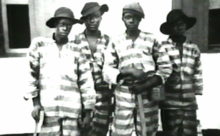Blues Like Showers of Rain: Background
A note by Daniel W. Patterson
This film opens with the statement “The Producers would like to thank Paul Oliver for the use of his personal collection of photographs and field recordings.” The British producer—John Jeremy—was young when he made this film and was working as a film editor for people like Otto Preminger. Blues Like Showers of Rain was his third film, all of them “short.” He would eventually be editor, director, producer, or writer for longer TV documentaries (a number about jazz, others about Hollywood films or celebrities--Clockwork Orange, Sam Peckinpah, Marlon Brando) until the year 2000. The importance of his Blues Like Showers of Rain rests on its being one of the first documentaries about blues singers and its being grounded in the fieldwork of Paul Oliver, a pioneering and major blues scholar.
Oliver himself was also English. His interest in African American music awakened when he was a teenager during WW II and happened to hear a field holler sung by black American soldiers at an army camp in Suffolk. Oliver went on to a prominent academic career as a scholar specializing in vernacular architecture. But he simultaneously threw himself passionately into the study of the blues. He was an intrepid field collector in the Deep South in dangerous years, recording performances and valuable interviews from working-class blacks from Texas, Louisiana, Mississippi, St. Louis, and Chicago, along the blacks’ migration trail from cotton fields to the urban North. Most of the singers had obscure lives. Some—like Muddy Waters, Otis Spann and J. B. Lenoir—became famous through commercial studio recordings. Oliver edited and published sound recordings from his own field tapes, and he was the author of fourteen books on blues, the last one just released in 2019, two years after his death at the age of ninety. Oliver’s 1965 book Conversations with the Blues is a compilation of blues singers’ accounts of their lives and the meaning of their blues music to them.
From the interview tapes for this book John Jeremy also edited the sound track for his 1970 film Blues Like Showers of Rain. He pieced together selections from the interviews to form an account of many aspects of the blues and interspersed them with performed blues. He did not go with Oliver to film on site. Portable cameras with sync-sound capabilities for field work were only then coming into use. He instead experiments with matching the music with scores of related photographs from Oliver’s collection. He shows singers, the land they lived and worked on, their families and communities, and places where they made music--the front porches where they sang away their blues, the street corners where they busked for pocket change, the juke joints and nightclubs where they played for dancers and greater pay. The film is a penetrating introduction to the music and the lives of the singers at the point in time when the blues tradition was transitioning from the music of solitary rural singers to bands entertaining at venues in urban ghettos. No academic talking head intrudes. The viewer gets deeply immersed in the social world and the lived experience of the blues singer. Perhaps the greatest value of the film is that it deeply impacts the viewers, however great their distance in time, place, social standing, and culture.
